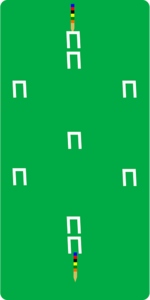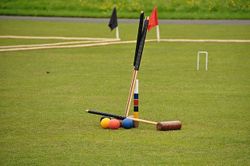Croquet: Difference between revisions
imported>Pat Palmer (rearranging the order of things) |
mNo edit summary |
||
| (9 intermediate revisions by 2 users not shown) | |||
| Line 1: | Line 1: | ||
{{subpages}} | {{subpages}} | ||
{{Image|Croquet-148672 640.png|left| | {{Image|Croquet-148672 640.png|left|150px|Diagram of how stakes and wickets are arranged on a croquet field.}} | ||
{{Image|Croquet pitch, Brodsworth Hall (9041).jpg|right| | {{Image|Croquet pitch, Brodsworth Hall (9041).jpg|right|250px|Croquet playing field showing a stake, balls, mallets and a wicket.}} | ||
'''Croquet''' is a sport of uncertain origin, | '''Croquet''' is a sport using wooden or carbon-fiber mallets to knock balls across a lawn, playable with average strength, speed, agility and endurance, barefoot or in any kind of shoes including high heels. It is of uncertain origin, believed to have been created in France and then imported to England, where it is most popular, and from there to the United States. The earliest known record of the name is dated 1856 and is contained in a set of rules for the game. It is played on a [[Lawn|lawn]], and the object is to be the first one to complete a course in which obstacles are set. | ||
Helpful skills for this sport include steadiness of hand and eye, and perhaps judgement, tactics or strategy, and knowledge of the capabilities, temperament, and likely behavior of one's opponents. There are politics in croquet, too--under some circumstances, players can meddle with the ball of another player, hindering or helping that player's progress around the court. It is deemed by many to be an excellent family game, suitable for persons of almost any age and physical capacity. | |||
One post serves as a starting point, and the other post the mid-way point. Play proceeds in a figure eight, counter-clockwise, around the court--wickets must be passed through in that exact order. If a player strikes a post with their ball, they are considered out of the game, so it is important not to strike either post until one's ball has passed through all wickets in the correct order. Each obstacle is a hoop through which the ball must pass in a prescribed order. The player hits the ball along the ground using a wooden mallet. The first player who first completes the course by moving the ball around the entire court, going through all the wickets, and hitting the home stake, is declared the winner. Unlike in golf, there is no need for actual counting of strokes. Each player's mallet is marked with a color that matches that player's ball color. | One post serves as a starting point, and the other post the mid-way point. Play proceeds in a figure eight, counter-clockwise, around the court--wickets must be passed through in that exact order. If a player strikes a post with their ball, they are considered out of the game, so it is important not to strike either post until one's ball has passed through all wickets in the correct order. Each obstacle is a hoop through which the ball must pass in a prescribed order. The player hits the ball along the ground using a wooden mallet. The first player who first completes the course by moving the ball around the entire court, going through all the wickets in the correct order, and hitting the home stake, is declared the winner. Unlike in golf, there is no need for actual counting of strokes. Each player's mallet is marked with a color that matches that player's ball color. | ||
Boasting is allowed in croquet, and may even be encouraged, as is jeering. | Boasting is allowed in croquet, and may even be encouraged, as is jeering. | ||
For more details, see Wikipedia's article on [[Wikipedia:Croquet|Croquet]]. | |||
==Notes== | ==Notes== | ||
{{Reflist}} | {{Reflist}} | ||
[[Category:Croquet]] | [[Category:Croquet]][[Category:Suggestion Bot Tag]] | ||
Latest revision as of 06:01, 3 August 2024
Croquet is a sport using wooden or carbon-fiber mallets to knock balls across a lawn, playable with average strength, speed, agility and endurance, barefoot or in any kind of shoes including high heels. It is of uncertain origin, believed to have been created in France and then imported to England, where it is most popular, and from there to the United States. The earliest known record of the name is dated 1856 and is contained in a set of rules for the game. It is played on a lawn, and the object is to be the first one to complete a course in which obstacles are set.
Helpful skills for this sport include steadiness of hand and eye, and perhaps judgement, tactics or strategy, and knowledge of the capabilities, temperament, and likely behavior of one's opponents. There are politics in croquet, too--under some circumstances, players can meddle with the ball of another player, hindering or helping that player's progress around the court. It is deemed by many to be an excellent family game, suitable for persons of almost any age and physical capacity.
One post serves as a starting point, and the other post the mid-way point. Play proceeds in a figure eight, counter-clockwise, around the court--wickets must be passed through in that exact order. If a player strikes a post with their ball, they are considered out of the game, so it is important not to strike either post until one's ball has passed through all wickets in the correct order. Each obstacle is a hoop through which the ball must pass in a prescribed order. The player hits the ball along the ground using a wooden mallet. The first player who first completes the course by moving the ball around the entire court, going through all the wickets in the correct order, and hitting the home stake, is declared the winner. Unlike in golf, there is no need for actual counting of strokes. Each player's mallet is marked with a color that matches that player's ball color.
Boasting is allowed in croquet, and may even be encouraged, as is jeering.
For more details, see Wikipedia's article on Croquet.

